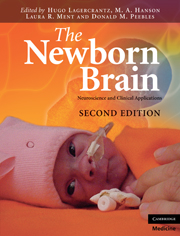Book contents
- Frontmatter
- Contents
- List of contributors
- Preface to the First Edition
- Preface to the Second Edition
- 1 Reflections on the origins of the human brain
- Section 1 Making of the brain
- Section 2 Sensory systems and behavior
- 9 Development of the somatosensory system
- 10 Principles of endogenous and sensory activity-dependent brain development: the visual system
- 11 Fetal and neonatal development of the auditory system
- 12 Newborn behavior and perception
- Section 3 Radiological and neurophysiological investigations
- Section 4 Clinical aspects
- Section 5 Follow-up
- Section 6 Consciousness
- Index
- Plate section
- References
10 - Principles of endogenous and sensory activity-dependent brain development: the visual system
from Section 2 - Sensory systems and behavior
Published online by Cambridge University Press: 01 March 2011
- Frontmatter
- Contents
- List of contributors
- Preface to the First Edition
- Preface to the Second Edition
- 1 Reflections on the origins of the human brain
- Section 1 Making of the brain
- Section 2 Sensory systems and behavior
- 9 Development of the somatosensory system
- 10 Principles of endogenous and sensory activity-dependent brain development: the visual system
- 11 Fetal and neonatal development of the auditory system
- 12 Newborn behavior and perception
- Section 3 Radiological and neurophysiological investigations
- Section 4 Clinical aspects
- Section 5 Follow-up
- Section 6 Consciousness
- Index
- Plate section
- References
Summary
Activity-dependent remodeling of early neural connections
As the human brain develops, billions of neurons cause an average of 1000 synapses to become interconnected in precise neural circuits. How are these complex neural connections established? Although many details are still poorly understood, the required steps are now understood in general outline. First, cells must be generated by successive cell divisions and their identity must be determined – as neurons, and then as particular classes of neurons. Second, neurons from one region must extend axons along specific pathways to appropriate target regions to form the linked pieces of a functional system. However, the initial pattern of connections is often imprecise. The third step is the refinement of these connections to form the specific patterns of connectivity that characterize the mature brain.
For the past half-century, the mammalian visual system has been the model of choice in which to examine the formation of precise neural connections. Neural activity in the visual systems is critical for sculpting its intricate circuits from initially imprecise connections. The necessity for normal visual input has been widely recognized as crucial for the developing brain, with loss of normal input leading to profound, irreversible changes in visual function. New experiments demonstrate a similar requirement for endogenous neural activity generated by the nervous system itself, long before the onset of vision. In this chapter, it is this last step of circuit formation – refinement controlled by neural activity – that will be discussed.
- Type
- Chapter
- Information
- The Newborn BrainNeuroscience and Clinical Applications, pp. 147 - 162Publisher: Cambridge University PressPrint publication year: 2010
References
- 1
- Cited by



